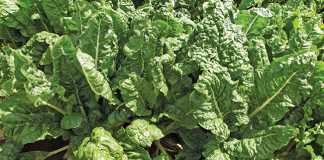On occasions, some growers have sown conventional types densely, and marketed these immature, pointy, young carrots as ‘baby carrots’. This does not work, as very immature carrots may well conform to size requirements but the taste is earthy and unacceptable. Flavour and eating quality improve towards maturity.
There are two basic types of baby carrots: the ‘finger’ type and the top-shaped type.
Finger type: Also known as the Amsterdam type, this comes in several varieties, and there are subtle differences in size and colour within the class. The carrots are cylindrical, with blunt tips.

The two groups on the right are both Chantenay Red Core grown under different conditions. Those on the far right are suitable for marketing as ‘baby carrots’. The other four groups of carrots (from left: Cape Market, Danvers 126, Regol and Chantenay Karoo) are shown for comparison. Photo by Bill Kerr
The top-shaped (Chantenay) type: A medium-length carrot tapering to a blunt tip, this is favoured by processors as it lends itself to mechanisation, unlike Amsterdams, which break easily.
With both types, rows are sown very much closer together than is the case with other carrots, and in-row spacing is also closer.
Read: Growing carrots
However, if you plant Amsterdams too close together, you will end up with unmarketable runts starved of sunlight. These are no better than weeds as they lower the yield by competing with the marketable product.
On the other hand, Amsterdam types have a smaller leaf growth, and if you have a stand which is on the sparse side, you will lose yield potential and end up with a slightly larger root.
If Chantenays are too sparse, the root is likely to grow to a normal size, unsuitable for this market.
With this type, you need a denser stand, so that the carrot is unable to grow ‘normally’ and hence produces the shorter top-shaped root that processors require.
Getting the nitrogen right
An important aspect is nitrogen fertilisation. Nitrogen stimulates leaf growth, so if too much is administered, some plants will grow a little faster and shade out neighbouring plants.
Read: Protecting a carrot crop
If nitrogen levels are high, apply a very heavy irrigation to leach the nitrate down to deeper layers, then follow up with frequent, lighter irrigation.
Getting the irrigation right
For all baby carrots, deep cultivation is unnecessary. Ideally, with regular carrots, you would provide progressively heavier irrigation to encourage a deeper root system.
With baby carrots, you need more frequent, lighter irrigation to prevent the roots from going too deep.
This is an abbreviated version of an article that appeared in Farmer’s Weekly 17 January.












